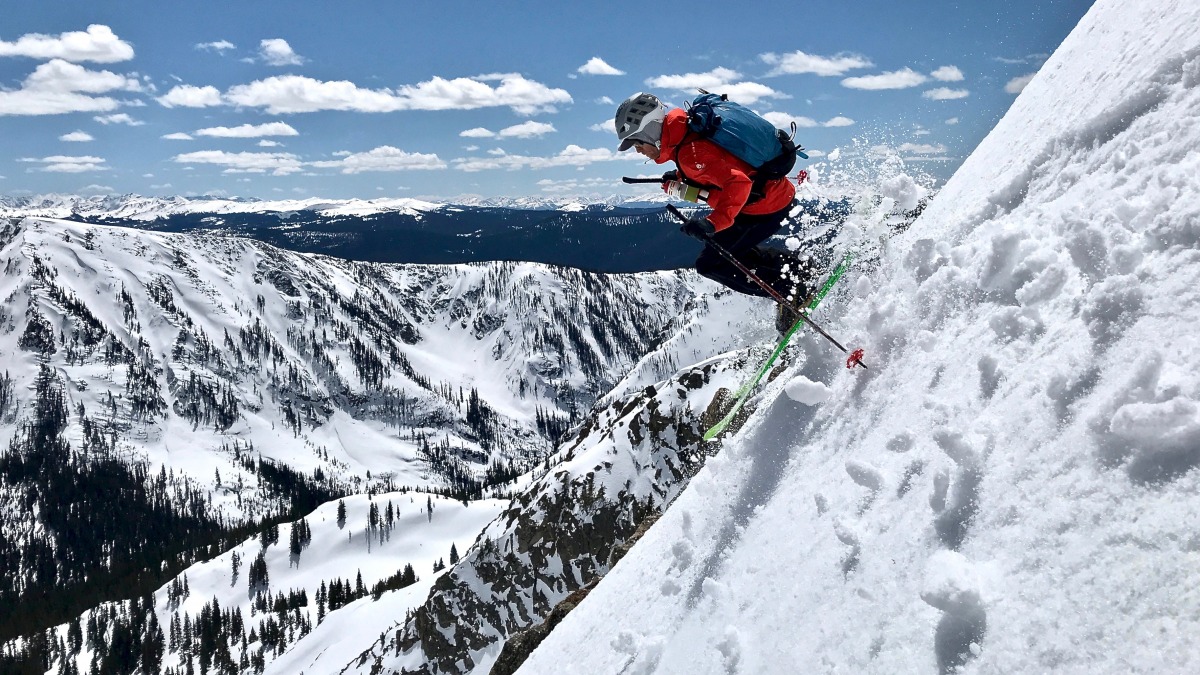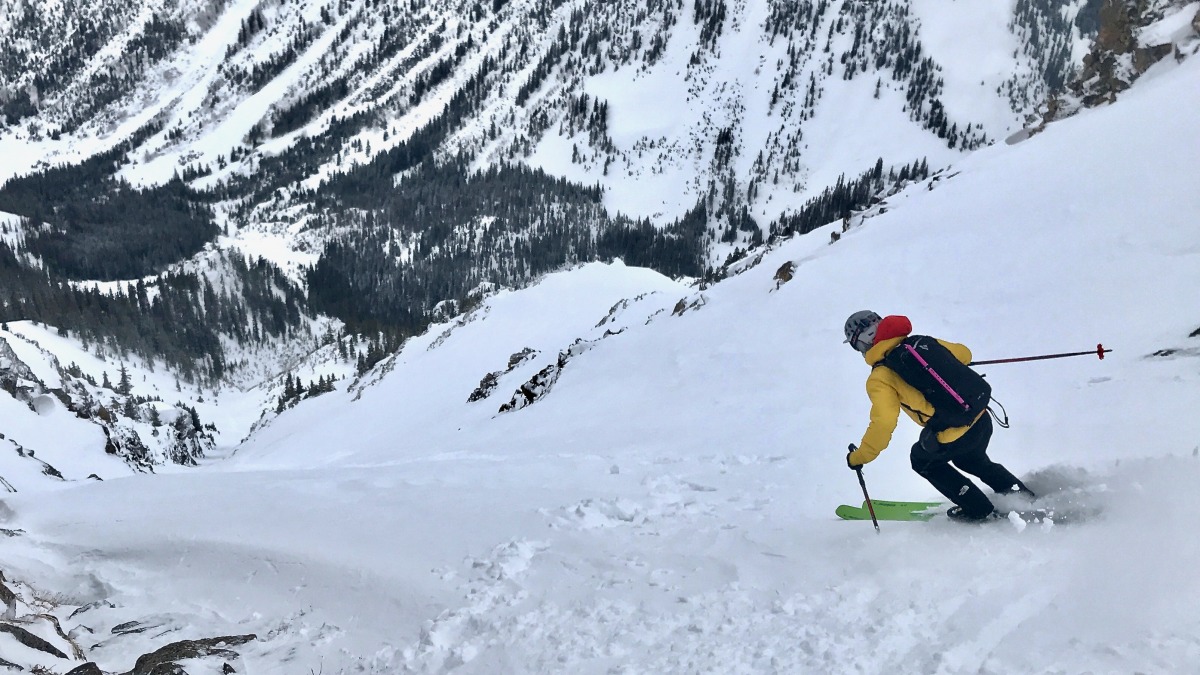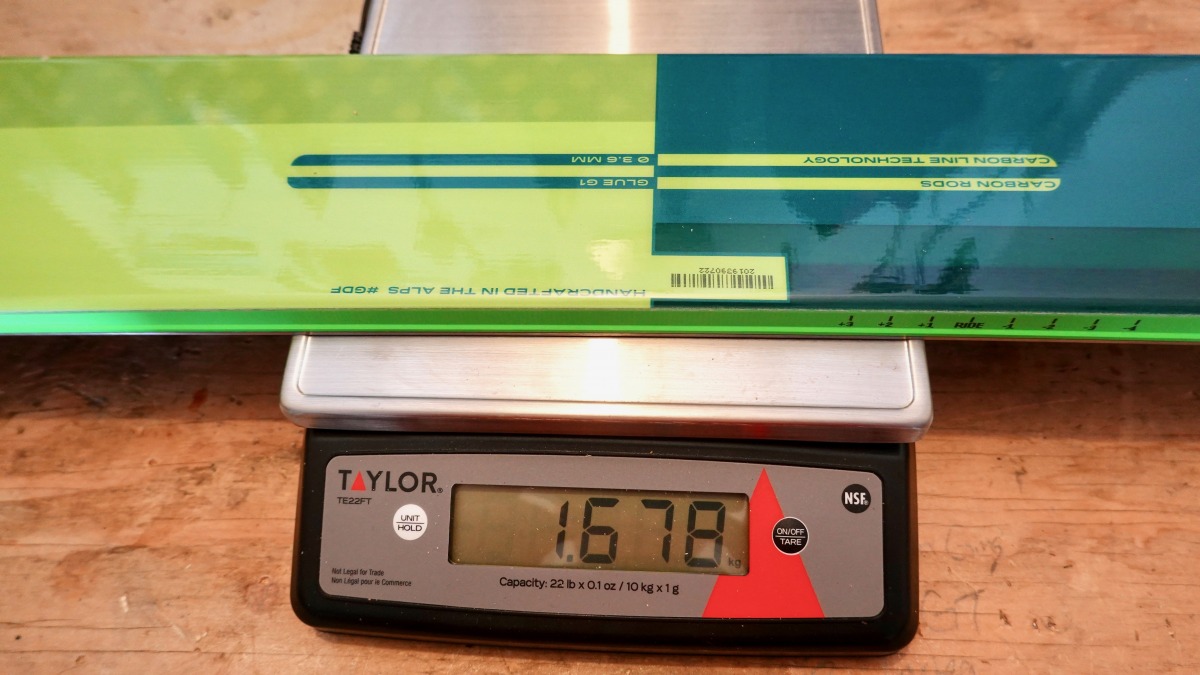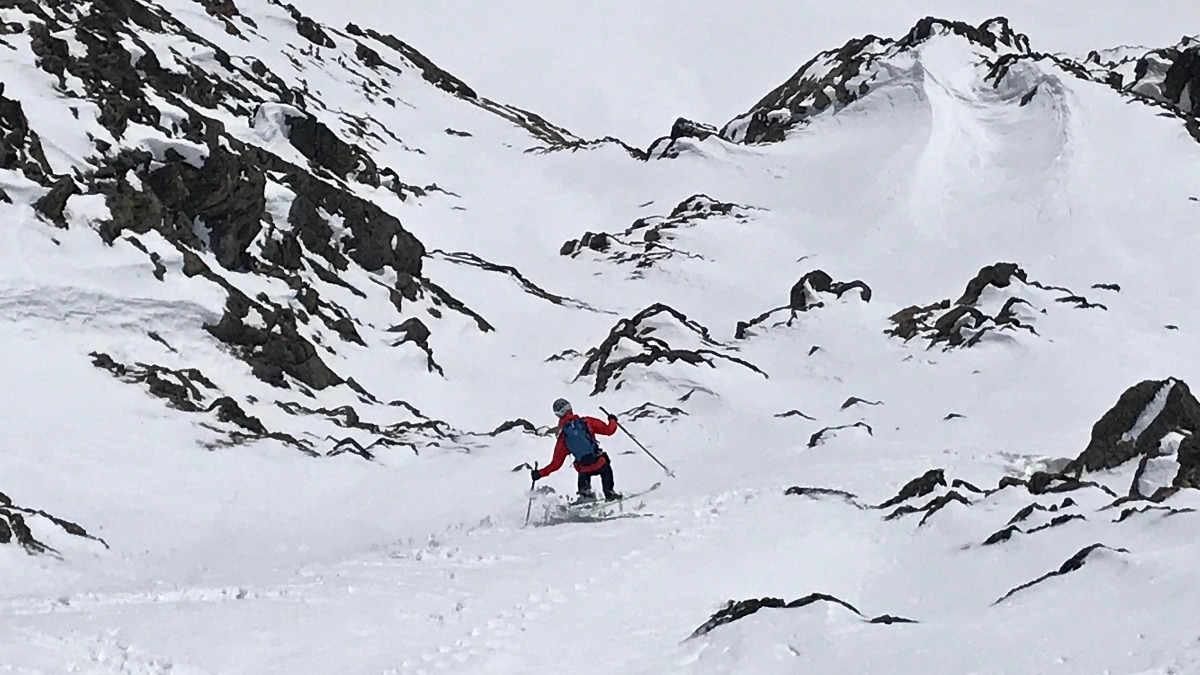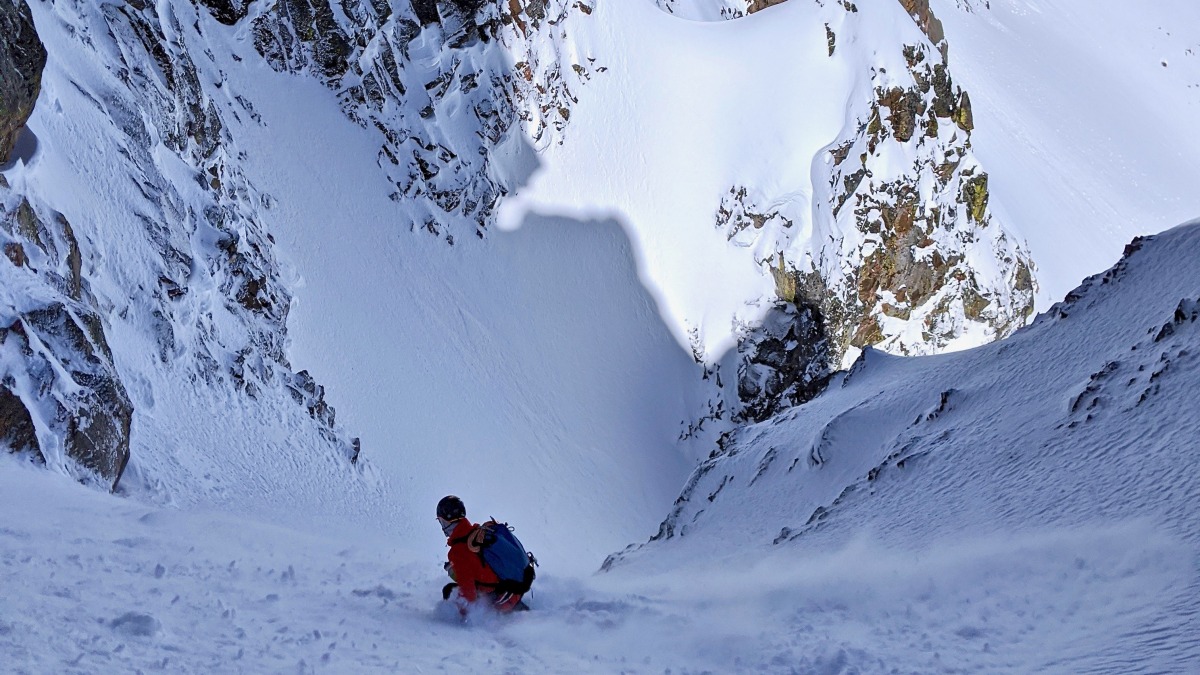Last spring I stood on top of a 2,300 foot couloir with an unskied pair of boards underfoot — the Elan Ripstick 96. The couloir was steep but not extreme and the snow slowly graduated from barely edge-able to trench-able boot top powder throughout the descent. The Ripsticks were sturdy, predictable and versatile beyond anything I had experienced in recent memory. What was this strange sensation? The Ripsticks ripped. These are alpine skis and I had been exclusively on skis designated “touring” for years.
I’ve made a habit of testing out new setups in the controlled environment that is the ski hill. Put some G-forces into the bindings and get a feel for ski flex and rebound before pushing them into more consequential terrain. The couloir mission was a morning one-and-done, so I reversed my habit and drove straight to the local ski hill to gain more nuanced insight of the ‘Sticks.
Tech/Design
When I was contacted by Elan to test a pair of skis last season, I must admit my Rocky Mountain bias pigeonholed Elans as only suited for crushing T-to-B groomers in between crushing Carlsbergs in an Austrian lodge. Alas, I should know better. These are Glenn Plake’s skis (he prefers the 105 model), free skiing icon, eternal purveyor of ski stoke, and my favorite Totally Deep Podcast guest to date.
The Ripsticks are built with Elan’s Amphibio Carbon Line construction with a primary objective of maximum power transmission to the downhill ski’s inside edge. The tip early rise is slightly asymmetrical with 4 cm more contact on the inside and a carbon fiber sheet lays over the core on the inside half only.
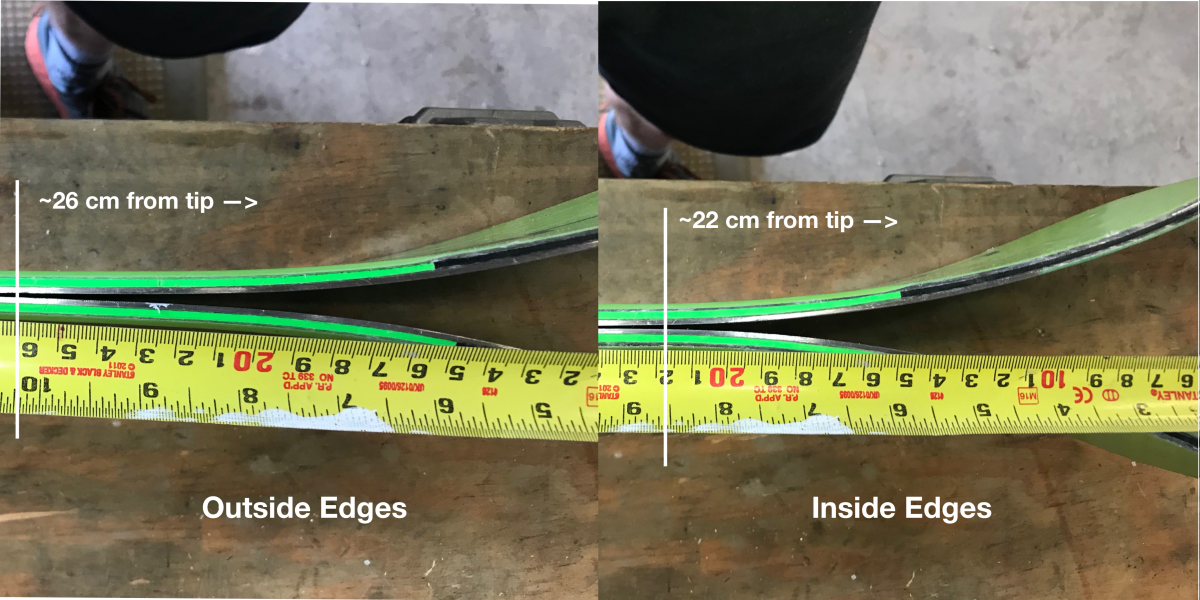
An extra 4-5 cm of contact on the inside edge makes for a more powerful grip and ability to really hammer the inside ski.
This being WildSnow, the right thing to do was to put them on the wrong feet. I took a few chair laps to see if I noticed a difference with my rights and lefts mixed up. I’d like to think I have a pretty refined palate for ski performance, but I could barely tell a difference. The skis were a little less smooth around the turn. Other than that, it was a wash, though I would guess an alpine boot and binding might make the differences more perceptible.
I made sure to maintain the correct placement for the remainder of the ski mountaineering season. One gripe is the very subtle Left and Right markers. I meant to put an obnoxious sticker on one tip, as several times I managed to get my skis on in some impossibly tiny and exposed spot, only to see them attached to the wrong boot.
The core is a wood laminate bored out longitudinally near the edges and reinforced with a couple of carbon tubes — adding stiffness while removing wood weight. The tip of the core is hollowed out and replaced by a synthetic material as many manufacturers are doing. Fiberglass reinforcement is used over the majority of the core for its superior downhill performance characteristics as compared to lighter yet less forgiving carbon sheets. Edges begin 10cm from the tip and end 2cm from a flat plastic tail cap, notched wide enough for any skin tail clip. The incomplete tail edges seem an unnecessary cop-out and potential durability issue, though no problems yet. Sidewalls run more or less the entire length.
Touring ski designers are often battling for your dollars with published grams counts. Make it light, then try to make it ski well. Any reduction in the Ripstick 96’s touring weight seems to be more tangential benefit of a ski designed lighter for downhill maneuverability and reduced swing weight. The 180cm 96 weighed in at 1678 grams. The 96’s would land near the bottom of Lou’s ski weight/surface comparison chart, though my math skills do not warrant an attempt at placing a number to them. Suffice to say they are a “heavy ski” in the WildSnow world.
Elan categorizes the Ripstick line as freeride. No Tall-T enthusiasts, not spinning off everything in sight or being featured in the latest TGR flick (though I’d imagine the 116 option would charge an Alaskan spine quite well). Freeride in the more sophisticated European sense meaning off-piste — including but not limited to human powered ups. Freedom from dodging tourists on moguls and corduroy.
The 96’s shaping is as refined as its image. Classic with a few modern touches like those asymmetrical tips and sizable taper from tip to tail. I waxed on about taper last season as a powerful shaping tool for backcountry skis. A 20mm tip to tail difference was the max of any non-Pontoon that I looked at. The 96mm Ripsticks utilize 26mm of taper with 136-96-110 dimensions yielding an 18m turn radius in the 180cm model. The pinner tail sinks while the wide tip planes in powder. The stiff tail and limited rear early rise retain power when it’s needed. Another win for tapered skis.
On snow
I was able to put 30-40 days on the Ripsticks last spring in the local high country. They were paired exclusively with a La Sportiva Skorpius CR boot, clamped in by the Black Diamond Helio 200, and mounted at 0 or “ride”. This is about as light as one would want to go on the boot, as the Ripsticks solid nature requires some forward input from the boot.
The Ripstick 96s excelled in every ski mountaineering condition encountered — corn in all of its varieties, sastrugi, spring powder, wind board, frozen, etc. The only condition I didn’t ski them in is bottomless powder. They would handle it fine though some combination of softer, fatter, and more rocker makes skis much more fun and playful in the deep.
In marketing the Ripstick 96, Elan keyed in on “smoothness”. It appears the design team did as well. The smoothness factor is fantastic in the variable conditions that come with alpine skiing. The Ripstick’s construction absorbs vibration while the dampened stiffness blasts through chunder allowing a powerful and confident stance.
The more proactive and aggressive you can be with any given equipment, the more solid your body positioning is. Many featherweight skis require some babying in variable snow so as to not get bucked around. This will inevitably put you in an upright or backseat position. With practice, light skis can be skillfully floated around a turn in less than ideal snow, but the ability to arc a turn while hammering the downhill ski and keeping the uphill inline with less effort yields confidence in consequential terrain. Then when it’s time to open it up on an apron, lay the Ripsticks over and smile as they rail GS turns with ease.
In summation
Best skis ever? Probably not if you are Mikaela Shiffrin arcing the world’s most perfect turns through World Cup gates. Sammy Carlson will not be stomping 540s in bottomless powder on these. Killian Jornet’s next FTK? Not on Ripsticks.
As a ski mountaineering tool however, the Ripstick 96 is brilliant. In fact, I could be quoted as saying that the Ripstick 96 is the best performing ski I’ve ever been on. These solid yet smooth skis have even helped me improve upon my steep skiing technique. With a full season of touring training, the weight was not an issue. The Ripsticks were underfoot for 15 plus mile missions covering over 8,000 ft of gain. The Ripsticks now sit idle in the garage, awaiting the high mountain coverage and stability of March and beyond. For now, the inferior floppy and rockered skis will have to do.
SPECS
Weight – 1678g (181)
Available lengths – 167cm, 174cm, 181cm, 188cm
Dimensions – 136mm – 96mm – 133mm (181)
Radius – 18m
Shop for the Elan Ripstick 96.
On March 22nd 2021, Gary Smith tragically died in an avalanche outside of Beaver Creek Resort in Colorado. Since 2018, Gary has been a frequent and insightful contributor to WildSnow. From Christmas Eve spent at the Wildsnow Field HQ cabin, to testing gear and sharing his love for steep skiing around the world, he was a pillar of the ski touring community and will be greatly missed.

